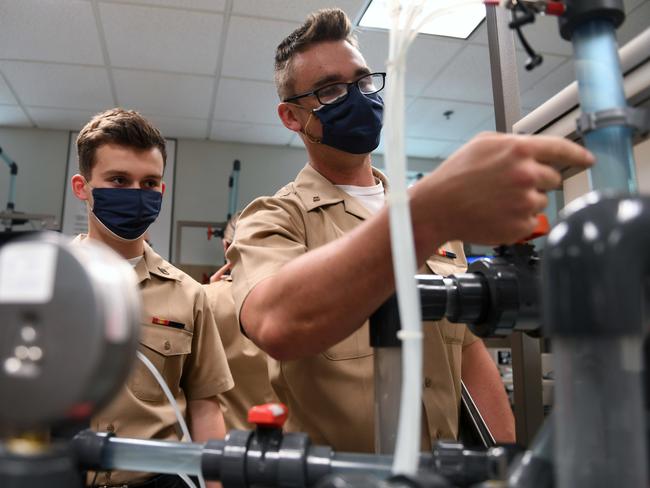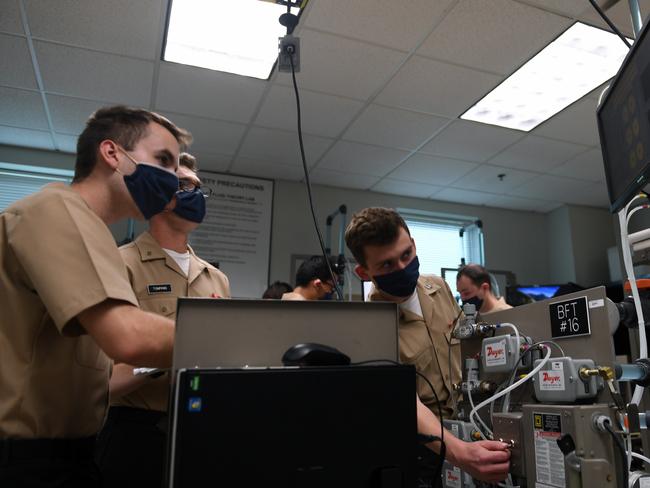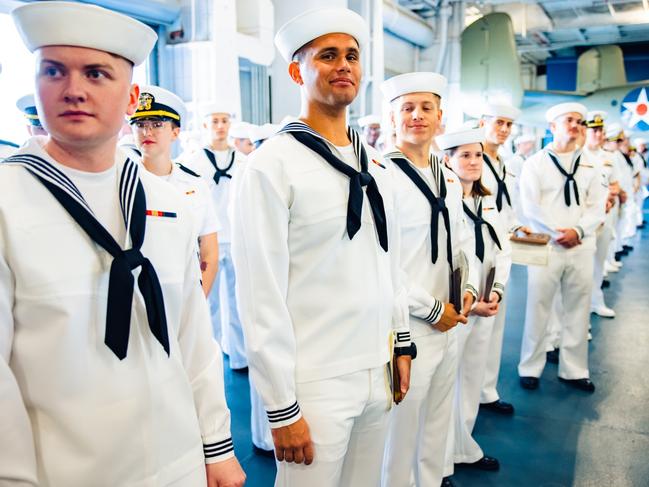Australians train with US nuclear submarine school
Australian Navy officers have enrolled in the US military’s most demanding academic program. See what the training involves.
World
Don't miss out on the headlines from World. Followed categories will be added to My News.
Five Australian Navy officers have joined the United States’s nuclear submarine school, paving the way for a domestic training program that will be critical to the success of the AUKUS pact.
Their enrollment in the Naval Nuclear Propulsion Program – which has trained more than 150,000 Americans over 70 years – is part of a sweeping effort to prepare Australia’s 900-strong submarine workforce to eventually man our own fleet of nuclear-powered boats.
The five officers have been based in South Carolina since the middle of the year, starting with the 24-week Nuclear Power School that is regarded as the US military’s most demanding academic program.
It provides a crash course on the science and engineering behind nuclear reactors, covering the maths, physics and chemistry skills needed to run them safely underwater.
“The program, while demanding, has so much to offer us as we prepare for Australian nuclear-powered submarines,” one of the Australian Navy officers said.
“I had no previous nuclear experience prior to this, apart from a keen interest. The US program is rigorous and they have loads of experience with this technology, and in equipping their sailors and officers with the knowledge and skills required to operate their fleet.”

The officer, who cannot be identified for security reasons, said that “learning from those who are the best in the field and alongside nuclear submarines is truly invaluable”.
After finishing at the Nuclear Power School, the Australians will head to one of two Nuclear Power Training Units for another 24-week program spent mostly aboard retired submarines.
There are three moored at the South Carolina unit, where executive officer Commander Daniel Turbeville said aspiring submarine officers were put through their paces with an extensive range of simulation exercises to prepare them for what they may confront at sea.
“The classroom knowledge and hands-on experience provided through the Nuclear Power Training Units are an important part of ensuring that naval nuclear propulsion plant operators are well-trained and qualified before reporting to their ships,” he said.
At the core of the program is something Commander Turbeville said was instilled by its creator Admiral Hyman G. Rickover, known as America’s “Father of the Nuclear Navy”.
“(He) recognised that nuclear propulsion plant operators must know more than simply what to do in any given situation – they must understand why,” Commander Turbeville said.
About 3000 American personnel are currently in training across the program, with recruits needing to be aged 19 to 29 with a university degree, preferably in a relevant technical area.
“Naval nuclear propulsion plant operators are carefully screened, selected and trained, and the standards for selection are high,” Commander Turbeville said.

They must have “the capacity and motivation to work hard”, he said, for which they are rewarded with a sign-on bonus of $US15,000 and another $US2000 upon completing their training. Prospective submarine officers who are recruited while still at university can also be paid more than $US4000 a month for up to 30 months before their graduation.
In Australia, as a final decision nears on how a nuclear-powered submarine fleet will be acquired, Navy chiefs are working with their American and British counterparts on a domestic training program to develop an eventual workforce of 2300 sailors.
The starting point is upskilling current officers, with the US training rotation accompanied by scholarships offered to complete Masters courses in nuclear science at the Australian National University and nuclear engineering at the University of New South Wales.
Vice Admiral Jonathan Mead, who is in charge of the Navy’s nuclear-powered submarine taskforce, said almost 30 people had entered nuclear training programs this year.
“In 2023, that number will probably exceed 50,” he said.
The Australian officers now studying in the US – who share decades of experience operating conventional submarines – are expected to serve on American nuclear-powered boats once they are qualified.

Chief of Navy Vice Admiral Mark Hammond said Australians had been part of crews on American and British submarines for decades.
“I myself have ridden in French, UK and US nuclear submarines,” he told a Senate hearing last month.
“The new component, really, is the additional training after the nuclear bulkhead, and that’s where we’re focusing a lot of our training and development over the coming decades.”
In the short-term, much of this training will have to happen overseas, particularly for Australian officers to get the hands-on reactor experience offered at the Nuclear Power Training Units in the US.
“Our partners in the UK and the US have an enviable track record when it comes to nuclear submarines, and we are in an excellent position to learn from them,” said one of the Australians from South Carolina.
“This training is an important part in building our knowledge base to eventually take back home. From here, we will be able to reach the point where we can have Australians training Australians.”

HOW AMERICAN SUBMARINE OFFICERS ARE TRAINED
RECRUITMENT
Prospective submarine officers must be US citizens aged 19 to 29. They must be graduates or students of a US university, preferably studying an area such as mathematics, engineering, physics or chemistry. They also need to meet the Navy’s physical standards.
OFFICER CANDIDATE SCHOOL
Training begins with a 12-week course in Rhode Island on the basic responsibilities of a Navy officer.
NAVAL NUCLEAR POWER SCHOOL
This is a 24-week course delivered in South Carolina covering the science and engineering behind nuclear reactors. Specialised subjects including thermodynamics, electrical engineering, reactor principles and radiological fundamentals.
NUCLEAR POWER TRAINING UNIT
A further 24-week program is completed at one of two units in either South Carolina or New York. Officers participate in hands-on simulation training on nuclear reactors, with three retired submarines moored at the South Carolina unit.
SUBMARINE BASIC OFFICER COURSE
Officers complete a final 12-week onshore course in Connecticut to learn about submarine operations, including safety, damage control, seamanship and sonar systems.
FIRST SEA TOUR
Officers spend the next three years assigned to a submarine, alternating between deployments, patrols, maintenance and local operations. By the end of this tour, they are designated as “Qualified in Submarines”.
SHORE ASSIGNMENT
Having completed their first sea tour, officers head back onshore for two years, filling roles in areas such as training, recruitment and strategy. This is an essential step to one day commanding their own submarine at sea.





